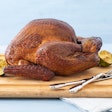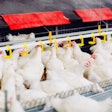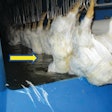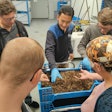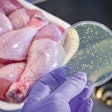Fly infestations in pig and poultry buildings could be costing livestock farmers 10 percent in lost growth rates and egg production. That could equate to over €10 (£8.50) per pig in extra feed requirement.
Speaking at the recent PestEx 2015 event in London, Syngenta Technical Manager, Dr. Kai Sievert, reported research studies have shown pig growth rates in untreated buildings with moderate house fly infestations, of six to 21 flies trapped per day on monitoring glue traps, were 121 days through the finishing unit, compared to just 109 days in adjacent buildings where the flies were controlled. Feed cost savings in the treated houses amounted to €15,000 a year per pig house with a capacity of 1500 head.
Other livestock can also be seriously affected by nuisance flies, he added. In poultry units, for example, cestodosis (internal worm parasites) transmitted by house flies reduced egg production by 10 percent. While beef units had seen weight gain reduced by up to 20 percent where infestations of Stomoxys calcitrans biting flies exceeded 100 insects per calf.
“Unless controlled by professional pest controllers or farmers, flies can carry over 100 different germs in the form of viruses, bacteria, fungi, and even worm eggs,” warned Dr. Sievert, “more than 65 of which can affect humans or animals. The movement of diseases, via mechanical transfer, by fly feces, fly saliva, or feeding, includes also the spread of the two most widely publicized risks to human health status: E. coli and Salmonella.”
He highlighted the presence of flies also created a bridge for disease, including between stock on different farms or buildings and from one batch of livestock to another passing through a building – no matter how thorough the physical cleaning or biosecurity measures. In these situations, the targeted use of Demand CS or Icon residual sprays and Zyrox baits can be effective in minimizing problem disease transmission.
Dr. Sievert pointed out that, with the current pressure on farmers to reduce the use of antibiotics in livestock production, there will almost inevitably be a higher background level of disease that will increase the potential risk of further spread by flies in the future. Thus the general hygiene situation has to be improved and fly control is a crucial important part of this.
Dr. Sievert advocated that farmers and pest controllers should now adopt an integrated approach to fly control, combining best practice to minimize fly populations with effective insecticide treatment of livestock buildings. He highlighted the value of physical barriers to prevent fly incursion into buildings and the need for better long-term control by removing the breeding grounds for flies.
But while mechanical methods could reduce fly numbers, for most farms chemical control was the primary route to effectively keep infestations below nuisance thresholds. Typically that would include the use of adulticides to quickly knock-down problem fly numbers, in combination with larvicides to break the cycle of population build-up.


.jpg?auto=format%2Ccompress&fit=crop&h=167&q=70&w=250)



